Fashion Native American Antque Gold Turquoise, Coral, Tiger's Eye Flower Dangle Earrings
4 Ways to Identify Antique and Vintage Jewelry
Annabelle / March 21, 2019
Perchance you've inherited something from your grandma, or you've recently been into austerity shops- you want to know more than about your jewelry, and the only matter that you're sure of is that it'southward one-time.
But where to start? Well, bank check out our antiquarian jewelry identification guide below.
What is Antique and Vintage Jewelry?
Vintage jewelry is jewelry that is at least thirty years old, while antique jewelry must be older than a century. This means that there are many different types of vintage and antique jewelry based on way trends, manufacturing styles, pop materials, and jewelry stamps.
4 Means of Identification
ane. Figure Out the Jewelry Way
Ane of the most telling ways to identify your jewelry is by its style, which tin correspond to a specific time period or area. Here's a brief breakdown of the nearly pop jewelry styles by era:
- Georgian (1700-1830): As one of the oldest and still commercially bachelor styles of jewelry, Georgian jewelry is named after the 4 kings that ruled England during this period. While this style tends to fluctuate due to the lengthy menses of time, it is known for its elaborate designs, colorful precious gemstones, and honey of yellow gold. Most pieces were part of a fix that could include necklaces, bracelets, rings, earrings, brooches, and even crowns. Due to historic period, many of these pieces are quite expensive.
- Victorian (1830-1900): Named after the reign of Queen Victoria, this style of jewelry was highly personal to the dearest queen, who was a style-setting icon of her time. During the first years of her marriage, a snake ring that was given to her past her married man, Prince Albert, became wildly popular. Later on his death, the public joined her method of mourning by wearing black jewelry, set with jet, onyx, and other somber gems such as garnets.
Non everything was gloomy, however; Queen Victoria owned a bright and cheerful bracelet with enameled hearts, which inspired jewelers to experiment with enamel in their ain creations. Other styles include acrostic jewelry, or jewelry that spelled out letters with the beginning letter of the types of stones: REGARDS (carmine, emerald, garnet, amethyst, diamond, and sapphire.) Towards the later part of the Victorian era, a fad for archæology was responsible for the creation of Egyptian and Ancient Greek designs. The ascent of the cameo, or a hard fabric carved into a portrait, is besides attributed to the Victorian era.
This cute trivial ophidian ring has a pair of cerise eyes and a diamond head.
- Edwardian (1900-1910): This way of jewelry refers to the proper name of King Edward VII, fifty-fifty though it connected for a menstruation of fourth dimension after his decease. It carries over some of the Victorian era's femininity with lacy and floral designs, but with a more than simple touch. White golden and platinum were popular, as well every bit garland designs that incorporated bows and leaves.

This beautiful grid bow piece embodies the Edwardian artful.
- Art Nouveau: (1890-1910): Overlapping the Victorian and Edwardian styles, Art Nouveau jewelry is a very distinctive manner that's characterized by nature-inspired designs and smooth, sweeping curves. The colors are more muted and natural, including stones such every bit opal, amber, and moonstone. Beautifully sculpted pieces of ladies with flowing hair commonly announced in this era.
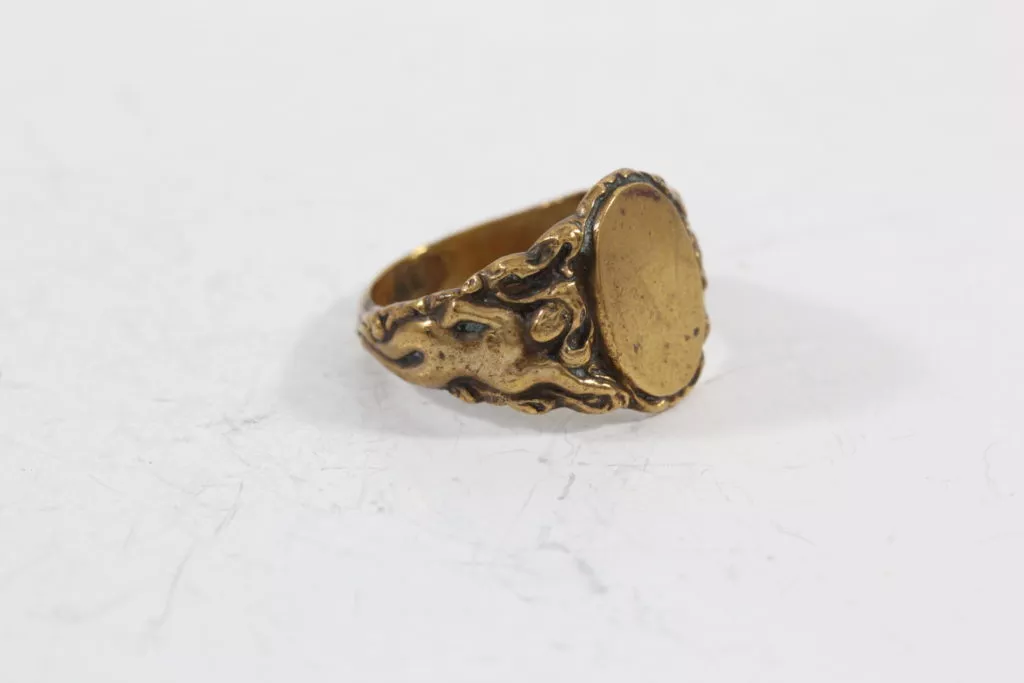
This brass ring shows typical Art Nouveau detailing; note the nude woman and the flowing, organic lines.
- Art Deco (1915-1935): If you lot've watched the Great Gatsby moving picture accommodation, you should have an inkling of what this style looks like! Art Deco pieces were assuming and modern, to reflect the growing flapper power of the day. This style combines sharp, geometric shapes with bright gemstones similar sapphires, rubies, and emeralds.

This white gold fine art deco ring is set with diamonds.
- Retro (1930-1940): The Retro jewelry mode was created during the war, when materials were scarce. As a upshot, synthetic and inexpensive materials became popular, such as plastic, rhinestones, and drinking glass. This gave birth to costume jewelry, made pop past Elsa Schiaparelli and other high-cease designers at the time.
In add-on to these historical styles, at that place are also some regionally-specific types of jewelry:
- Southwestern: Inspired and produced past Native American artisans and silversmiths, these designs are usually fabricated out of sterling silvery or leather, with turquoise, coral, mother-of-pearl, and malachite every bit common materials. Designs include plume motifs, stamped patterns, conchos, and indigenous art.

Two examples of southwestern rings.
- Black Hills: Originating from the gold blitz in South Dakota, Black Hills gold has a unique look due to its usage of unlike aureate colors, including yellowish, pinkish, and green. Grapevines and grape leaves make the designs distinctive and hands identifiable. In order for an item to be called Black Hills gilded, it must be manufactured in Due south Dakota.
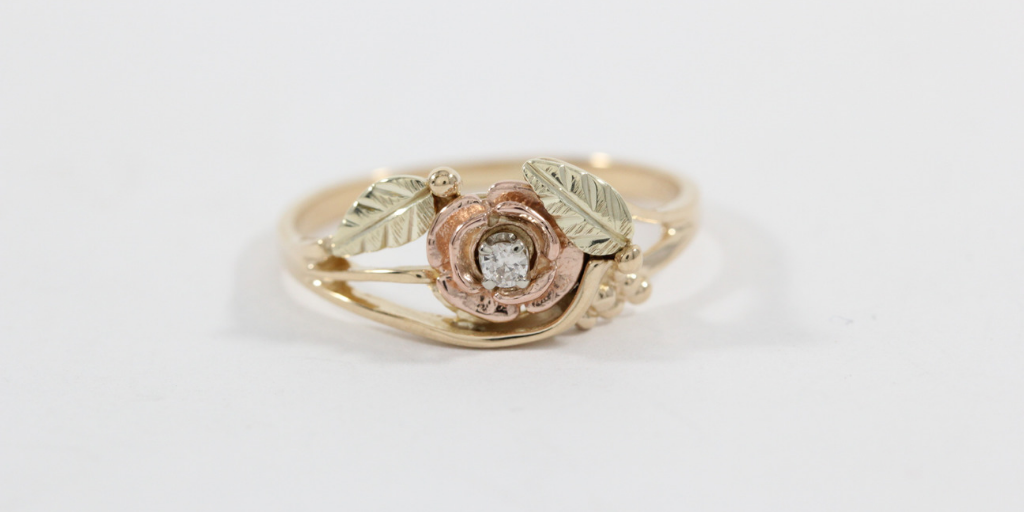
This Black Hills ring shows off the signature multicolored gold look, with grape leaves.
ii. Take Note of Manufacturing Methods
While manufacturing methods drastically vary, certain components and details are very telltale when it comes to dating the jewelry. For instance, hand engraving is indicative of a piece dating at least to the 1900s, especially if it is on a signet ring. Incredibly intricate, small, and lacy filigree work, in combination with white golden or platinum, volition frequently point to Edwardian or Art Deco jewelry. Even stones can be affected; auto stone cutting was introduced in the early 1900s, which created the round brilliant cutting that is notwithstanding the most pop diamond cutting today. Prior to that, jewelry from previous eras were set with quondam, hand-cutting gems, such as the rose cutting for Georgian and Victorian jewelry and the European cut for Edwardian and Fine art Nouveau jewelry.
Countries have different standards for their metals as well, which will allow yous to figure out where your detail is from. Equally an example; the The states does not consider anything less than 10k (41.6%) gilded to be considered gilt jewelry. In the U.k., however, 9k gold is very pop and this is a mutual indicator that the item was manufactured there.

This beautiful signet ring was probably mitt-engraved with the owner's initials.
iii. Spot Popular Materials
Bated from gemstones and metals, dissimilar materials were introduced to jewelry at certain points in fourth dimension. A short list of these materials include:
- Bakelite: The start synthetic plastic, bakelite was created in New York in 1907. Bated from its versatility in creating household implements, information technology was also used in jewelry due to its unique look and variety of colors, including transparency. Nowadays, it has get a popular collector'southward particular.
- Camphor Drinking glass: A blazon of glass made from hydrofluoric acid treatment in gild to give it a frosted appearance. Information technology start appeared in the late 1800s as a form of mourning jewelry, but somewhen became mainstream. Typical pieces from the 1800s to early 1900s are framed with silver or white gold, with delicate grid work and occasional marcasite or rhinestone accents.
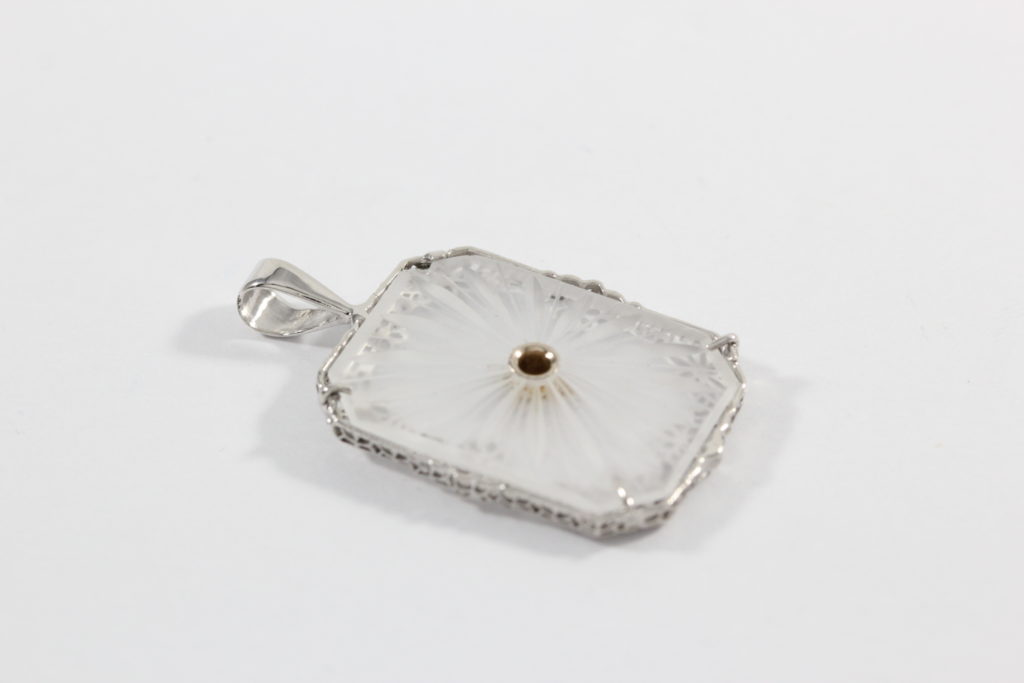
A vintage pendant made from camphor glass.
- Paste: An old term for rhinestone, the material used to create paste stones has changed over fourth dimension from rock crystals to crystal glass and plastic. This range of composition allows for farther dating of the item, as earlier, antiquarian jewelry pieces would contain manus-cutting pieces of stone crystal paste instead of a more than modern alternative such every bit plastic.

This beautiful pair of earrings was fabricated from two century-former rhinestones.
- Foil Opals: A simulated gemstone that was really a slice of glass over a thin sheet of sparkly metal, in order to mimic the look of a natural opal. These were introduced in the belatedly Victorian era, and are different from other synthetic opals that were made from plastic or sparkly drinking glass. Yet, the term "foil opal" is now commonly used to refer to all faux opals. These stones are also popularly used in vintage costume jewelry, especially from Mexican manufacturers.

This piece, probably of Mexican origin, has a more than contemporary foil opal.
- Palladium: Palladium is a shiny argent-white metal that entered jewelry manufacturing during the 1930s, as platinum had been reserved for war machine apply during the war. It is lighter than platinum, but retains its color much better than white aureate, which has a tendency to turn yellow with habiliment. As a issue, a piece of jewelry made from palladium will well-nigh likely date from the 1930s or later.

A modern palladium ring.
4. Look for Jewelry Stamps
Jewelry stamps or hallmarks on the piece often help determine an item'south origins, or even the year information technology was made. Some manufacturers were in performance upward until a specific twelvemonth, and other manufacturers modify their company hallmark over time. Metal stamps, such as 14k, 18k, 925 (for sterling silverish), and PLAT or 950 for platinum tin can besides assist you place the textile.
Country-specific hallmarks are also nifty for determining the item's location of manufacturing. For instance, the United kingdom has very well-established assay marks, or metal stamps and other symbols that bespeak where the item was tested and certified for its metal content. In that location are four offices in the UK that are immune to assay jewelry- London, Sheffield, Birmingham, and Edinburgh. Each of these offices have their own respective assay stamp (in order): a leopard'southward head, a rose, an anchor, and a castle. You'll find that every country has their ain standards for marking items, and their own unique symbols.
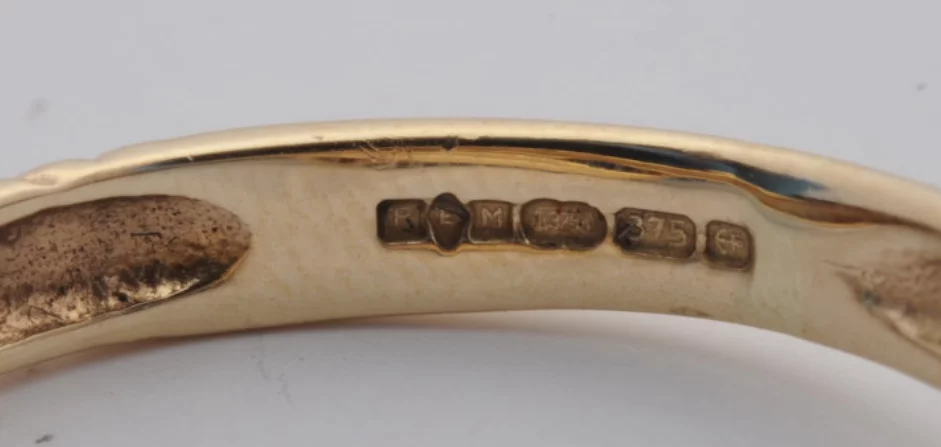
This ring is fabricated from 9k gold (37.5%) and has a articulate Birmingham anchor stamp.
Revival Jewelry and Imitations:
Not all vintage or antique-looking jewelry is actually vintage or antiquarian! Exist careful of fakes or revival jewelry, which are pieces that emulate older jewelry styles. It tin can exist difficult to tell, but cheaper materials are usually a dead giveaway. Taking it to an appraiser or a jeweler will as well allow you to determine if the piece is legitimate or non.
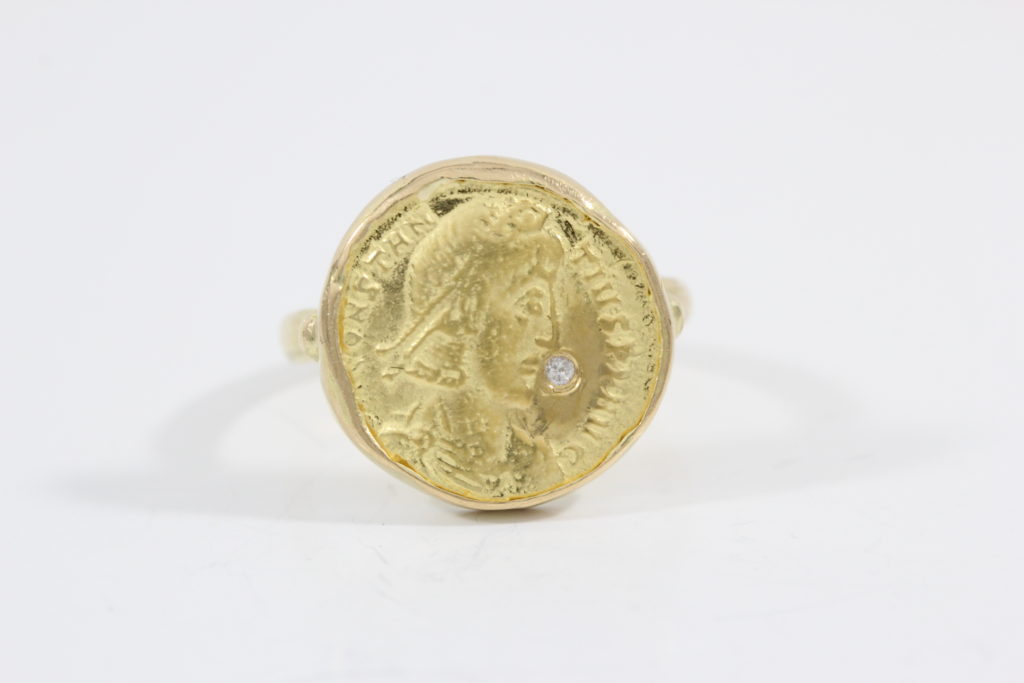
An Ancient Roman revival coin ring
Now you should be fix to practice some jewelry investigating on your ain afterward reading this antique jewelry identification guide! Annotate below if you lot take a cool piece you'd like to share, or let usa know if you're interested in vintage jewelry repair!
0 Response to "Fashion Native American Antque Gold Turquoise, Coral, Tiger's Eye Flower Dangle Earrings"
Post a Comment